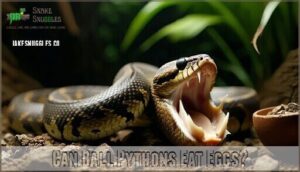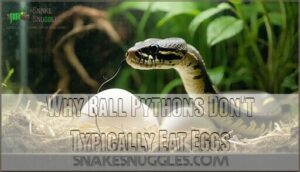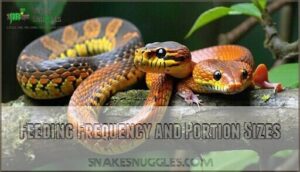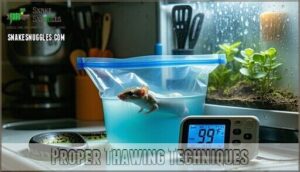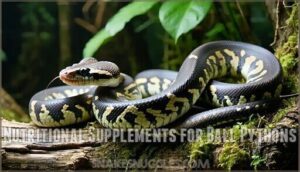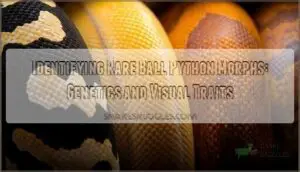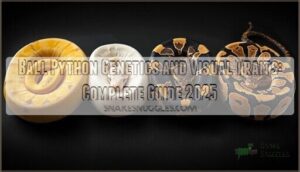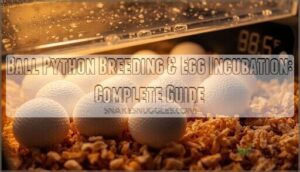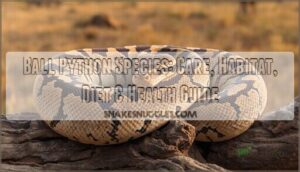This site is supported by our readers. We may earn a commission, at no cost to you, if you purchase through links.
 You shouldn’t let your ball python eat eggs.
You shouldn’t let your ball python eat eggs.
While some snake species enjoy eggs as part of their natural diet, ball pythons aren’t built for it.
Their jaw structure and hunting instincts are designed for warm-blooded prey like rodents.
Eggs lack the complete nutrition your snake needs and can cause digestive issues or even choking hazards.
Think of it like feeding your cat a steady diet of crackers – technically possible, but not what nature intended.
Your ball python thrives on appropriately-sized rodents that provide balanced nutrition.
Understanding what makes the perfect meal for your scaly friend involves more than you might expect.
Table Of Contents
- Key Takeaways
- Ball Python Diet Basics
- Can Ball Pythons Eat Eggs?
- Why Ball Pythons Don’t Typically Eat Eggs
- Appropriate Food Sources for Ball Pythons
- Feeding Frequency and Portion Sizes
- Preparing Food for Ball Pythons
- Common Feeding Issues in Ball Pythons
- Nutritional Supplements for Ball Pythons
- Feeding Environment and Techniques
- Monitoring Your Ball Python’s Health
- Frequently Asked Questions (FAQs)
- Conclusion
Key Takeaways
- Don’t feed your ball python eggs – they can’t digest eggshells properly and face serious choking hazards and digestive blockages that could prove fatal.
- Stick to frozen-thawed rodents – your python’s jaw structure and heat-sensing abilities are designed for warm-blooded prey like mice and rats, not cold eggs.
- Eggs lack complete nutrition – unlike whole rodents, eggs don’t provide the balanced amino acids, vitamins, and minerals your ball python needs for proper health and growth.
- Follow proper feeding schedules – feed hatchlings every 5-7 days, juveniles weekly, and adults every 10-14 days with appropriately-sized prey that matches your snake’s girth.
Ball Python Diet Basics
Your ball python’s diet needs are surprisingly simple once you understand their carnivorous nature.
Feeding your ball python right is easier than you think—stick to their carnivorous roots and watch them thrive.
These snakes thrive on rodents like mice and rats, which provide all the nutrients they need to stay healthy and grow properly.
Natural Prey in The Wild
In their African habitat, ball pythons hunt wild rodents like mice and rats as their primary food source.
They’ll also grab avian prey when birds nest low enough.
Young pythons focus on insect consumption since bugs are easier to catch and digest.
Prey availability changes with seasons, but habitat diet studies show they rarely encounter eggs naturally, making ball python egg eating uncommon in the wild, due to the primary food source being something else.
Captive Feeding Practices
Captive feeding practices boil down to creating a controlled environment that mirrors your ball python’s natural hunting instincts.
Unlike wild pythons, yours will thrive on a structured routine that prioritizes safety and nutrition.
- Frozen-thawed rodents eliminate injury risks while maintaining proper ball python diet standards
- Scenting techniques help trigger natural feeding responses in picky eaters
- Prey enrichment through proper heating mimics fresh kills
- Obesity prevention requires monitoring portion sizes and feeding frequency
This approach supports healthy python feeding habits while ensuring consistent hydration methods.
It’s vital to thaw frozen prey safely before feeding.
Can Ball Pythons Eat Eggs?
You might wonder if your ball python can snack on eggs like some other snake species, but the answer isn’t straightforward.
Ball pythons face serious health risks when eating eggs, including choking hazards and digestive problems that can prove fatal.
Nutritional Considerations
When considering snake egg nutrition for your ball python, you’re basically asking if a square peg fits a round hole.
Eggs don’t provide the nutritional benefits your snake needs for proper dietary balance. While eggs contain protein, they lack the complete amino acid profile found in whole prey.
Ball pythons thrive on a diet of whole prey, and prey size matters for ideal health.
| Nutritional Factor | Eggs vs. Rodents |
|---|---|
| Protein Quality | Incomplete vs. Complete |
| Vitamin Needs | Deficient vs. Adequate |
| Mineral Intake | Imbalanced vs. Balanced |
| Hydration Importance | Low vs. High |
| Obesity Prevention | Poor vs. Excellent |
Rodents provide superior snake nutrition, preventing nutritional deficiencies while supporting ideal health through balanced nutritional considerations.
Potential Risks
While eggs might seem harmless, they pose serious snake egg health risks for your ball python.
Egg digestion problems can cause impaction risks since pythons can’t break down shells properly.
Bacterial concerns include snake egg salmonella risks from contaminated eggs.
The choking hazard is real—eggs can get stuck in their throat.
Nutritional deficiencies develop because eggs lack complete nutrients found in rodents.
These snake egg bacteria risks make eggs a dangerous choice.
Improper humidity can contribute to shedding and skin problems.
Why Ball Pythons Don’t Typically Eat Eggs
Your ball python’s mouth isn’t built for cracking eggs like you’d crack them for breakfast.
These snakes hunt using heat-sensing pits that detect warm-blooded prey, but eggs don’t give off the body heat that triggers their natural feeding response.
Mouth Structure
Unlike egg eating snakes with specialized skull adaptations, your ball python’s mouth structure tells a different story.
Their backward-angled teeth morphology creates a one-way grip system designed for live prey ingestion, not smooth eggs.
While jaw flexibility allows impressive gape size expansion, the curved dental structure would struggle with spherical objects.
Ball pythons rely on their heat-seeking pits to find prey.
Here’s why their snake anatomy doesn’t support egg consumption:
- Teeth curve backward to prevent prey escape during constriction
- Heat-sensing pits detect warm-blooded animals, not cold eggs
- Jacobson’s organ identifies chemical signals from living creatures
- Jaw ligaments optimize for flesh-based prey manipulation
- Tooth spacing creates gaps unsuitable for egg-eating adaptations
Hunting Behavior
Ball pythons are hardwired ambush predators that hunt using precise instincts.
Your snake’s hunting behavior explains why egg eating behavior doesn’t match their natural programming.
These serpents rely on sophisticated prey detection systems that target live, warm-blooded animals in their natural habitat.
Here’s how their hunting instincts work:
- Scent Tracking – They follow chemical trails left by rodents and birds
- Ambush Tactics – Patient waiting in burrows for unsuspecting prey
- Strike Accuracy – Lightning-fast constriction methods designed for moving targets
Appropriate Food Sources for Ball Pythons
Your ball python’s health depends on feeding the right prey items that match their natural diet.
Rodents like mice and rats form the foundation of proper nutrition, while other options like birds and insects can supplement their meals safely.
Rodents as Primary Diet
You’ve learned why eggs aren’t suitable for your ball python, so let’s focus on what works best. Rodents form the backbone of a healthy ball python diet, mimicking their natural African habitat preferences. These prey items deliver complete nutritional value while being cost-effective and readily available.
Frozen vs live prey sparks debate among keepers, but frozen-thawed rodents win for safety and convenience. They eliminate bite risks and store easily. Your snake’s rodent preference typically shifts from mice to rats as they grow—this change prevents feeding issues later.
| Life Stage | Rodent Size | Feeding Frequency |
|---|---|---|
| Hatchling | Hopper mice | Every 5-7 days |
| Juvenile | Fuzzy rats | Every 7-10 days |
| Adult | Medium rats | Every 10-14 days |
Monitor your snake’s weight regularly. Obesity risks increase with overfeeding, making proper scheduling essential for long-term health.
Other Suitable Prey Items
While rodents form the backbone of your ball python’s diet, you can introduce variety with other prey options.
Think of it as adding different flavors to their menu while keeping safety first.
Here are suitable alternative prey items:
- Bird Options – Quail chicks provide excellent nutrition and mimic wild hunting experiences
- Alternative Rodents – Gerbils and African soft-furred rats offer size variety for growing snakes
- Insect Variety – Younger pythons benefit from appropriately-sized insects as supplementary feeding
- Safe Handling – Always make certain prey size matches your snake’s girth for comfortable swallowing
Remember, eggs aren’t suitable for ball python egg eating despite what you might think about snake diet variety.
Feeding Frequency and Portion Sizes
Your ball python’s feeding schedule depends on its age, with young snakes eating every 5-7 days while adults can wait 2-3 weeks between meals.
You’ll need to match prey size to your snake’s body width, starting with pinkie mice for babies and moving up to medium rats as they grow.
Age-based Feeding Schedule
Timing your ball python’s meals correctly makes all the difference in their health.
Hatchling feeding requires meals every 5-7 days, while juvenile portions stretch to weekly intervals.
Adult frequency drops to every 10-14 days as their metabolism slows.
Your age-based diet approach guarantees proper growth without overfeeding.
Senior adjustments may require even longer gaps between meals.
It’s also important to consult a snake feeding schedule for specific guidelines.
Prey Size Guidelines
The right prey size makes all the difference in your ball python’s health and happiness. Think of it as finding the perfect-fitting shoe – too small won’t satisfy, too large creates problems.
- Hatchlings (0-3 months): Feed hopper mice every 5-7 days, matching your snake’s ideal girth at its widest point
- Juveniles (3-12 months): Offer adult mice every 7-10 days as hatchling portions become inadequate
- Sub-adults: Medium rats every 10-14 days prevent undersized prey issues while avoiding overfeeding risks
- Adults (3+ years): Large rats every 14-21 days provide satisfying adult meals
Follow these rodent size guidelines for a healthy, size-based diet that grows with your python.
Preparing Food for Ball Pythons
You’ll want to get your ball python’s food ready the right way to keep your snake healthy and safe.
Proper preparation means choosing between live and frozen prey, then thawing frozen rodents correctly to prevent harmful bacteria from growing.
Live Vs. Frozen-Thawed Prey
You’ll find frozen-thawed prey offers clear advantages over live options for your ball python.
Frozen benefits include safer handling, bulk storage, and reduced live prey risks like bites or scratches.
Ethical concerns around live feeding also matter, and nutritional differences are minimal between both options.
Switching methods from live to frozen requires patience and proper warming techniques.
To guarantee safety, remember to follow prey preparation methods before feeding.
Proper Thawing Techniques
Once you’ve decided on frozen-thawed prey, mastering safe thawing becomes your next priority. Think of it like preparing a gourmet meal – you wouldn’t serve cold leftovers to guests, right?
Temperature control starts with moving your frozen rodent from freezer to refrigerator overnight. This gradual thawing process prevents bacteria prevention issues while maintaining nutritional retention.
For faster results, seal the prey in a waterproof bag and submerge in warm water, changing it every 15 minutes. These bags can be found through various online retailers.
Here are five essential thawing methods for ideal python feeding:
- Refrigerator thawing – safest overnight method
- Warm water bath – faster 30-60 minute option
- Room temperature – convenient 2-3 hour approach
- Never microwave – destroys nutrients and creates hot spots
- Check internal temperature – aim for 98-100°F before feeding
Proper thawing techniques guarantee your snake feeding routine stays healthy and stress-free.
Common Feeding Issues in Ball Pythons
You’ll likely encounter feeding challenges with your ball python at some point, from stubborn hunger strikes to unexpected regurgitation episodes.
Understanding these common issues helps you respond quickly and keep your snake healthy during feeding difficulties.
Refusal to Eat
When your ball python suddenly stops eating, don’t hit the panic button just yet. Appetite loss happens for several reasons, and most are easily fixable.
Here’s what might be causing your snake’s food strike:
- Stress Factors – Recent handling, cage cleaning, or new tank mates can trigger feeding refusal
- Environmental Issues – Wrong temperatures, humidity levels, or lighting schedules disrupt natural feeding patterns
- Shedding Cycle – Snakes typically refuse food before shedding, which is completely normal behavior
Monitor weight loss and consult a vet if refusal continues. Maintaining proper temperatures with a reptile heating pad is essential for their digestion.
Regurgitation
Looking at ball python regurgitation, you’ll notice it’s more common than you’d think. Stress, overhandling, and poor temperatures typically cause this digestive issue.
Watch for lethargy and visible food remnants in your python’s stomach area.
| Regurgitation Causes | Prevention Methods | Health Concerns |
|---|---|---|
| Temperature fluctuations | Maintain proper heat | Dehydration risk |
| Handling after feeding | Wait 48+ hours | Nutritional loss |
| Oversized prey | Follow size guidelines | Stress response |
| Illness/parasites | Regular vet checkups | Digestive damage |
If regurgitation occurs, wait two weeks before offering smaller prey.
For appropriate prey size, consider using pre-killed rodent options.
Nutritional Supplements for Ball Pythons
You don’t need to add vitamins or minerals to your ball python’s diet if you’re feeding whole prey like mice and rats.
These complete meals already contain all the nutrients your snake needs, making supplements unnecessary and potentially harmful if used incorrectly.
Vitamin and Mineral Requirements
Your python’s nutritional needs center around whole prey, but calcium needs and essential vitamins matter too.
Commercial feeder rodents sometimes lack proper mineral balance, creating potential mineral deficiencies.
You’ll want a balanced calcium-to-phosphorus ratio for healthy bone development.
While whole prey typically covers most vitamin and mineral requirements, captive environments can create gaps.
Supplementing diet becomes important when feeder animals lack vitamin D or other nutrients.
Hydration importance also plays a role in nutrient absorption and overall python nutrition.
When Supplements Are Necessary
Although your ball python typically gets complete nutrition from whole prey, certain situations call for nutritional supplements.
Watch for deficiency signs like lethargy or poor shedding, which may indicate supplement needs.
- Supplement Types: Calcium with vitamin D3 for bone health
- Dosage Concerns: Light dusting every 4th feeding prevents over-supplementation
- Hydration Importance: Proper water intake enhances supplement absorption
- Vet Consultation: Professional guidance guarantees safe calcium supplementation practices
Feeding Environment and Techniques
Creating the right feeding setup can make or break your ball python’s mealtime success.
You’ll want to choose between feeding in their main enclosure or using a separate container, plus know exactly when to step back and let them eat in peace.
In-Enclosure Vs. Separate Feeding Area
Your feeding location choice impacts your ball python’s wellbeing substantially.
In-enclosure feeding promotes stress reduction and prevents handling-related anxiety, though hygiene concerns arise from substrate ingestion.
Separate feeding areas address cleanliness but may create habituation issues where your snake associates handling with meals, potentially triggering defensive responses.
| In-Enclosure Feeding | Separate Feeding Area |
|---|---|
| Reduces stress levels | Prevents substrate ingestion |
| Eliminates handling trauma | Maintains enclosure cleanliness |
| Natural feeding environment | Requires additional setup |
| Risk of substrate consumption | May increase snake anxiety |
Owner preference often determines the best approach for snake safety.
Handling During Feeding Time
Success in snake handling during feeding time hinges on understanding your python’s behavior patterns.
Proper post-feeding care and owner safety protocols will prevent handling stress and reduce cage aggression risks.
Here’s your roadmap for safe handling during feeding sessions:
- Wait 48-72 hours after feeding – Your python needs time to digest without the stress of movement, which prevents regurgitation and keeps both of you safe.
- Use feeding tongs exclusively – Long tongs create distance between your hands and your snake’s strike zone, eliminating confusion between food and fingers.
- Implement tap training – Gently tap your python with a hook before handling to signal it’s interaction time, not feeding time, reducing defensive responses.
Monitoring Your Ball Python’s Health
You’ll need to track your ball python’s weight and growth patterns to catch health problems early.
Regular monitoring helps you spot signs of malnutrition or overfeeding before they become serious issues that could harm your snake, allowing for intervention to prevent severe consequences related to malnutrition.
Weight and Growth Tracking
Tracking your ball python’s weight and growth becomes your roadmap to understanding their health.
Weigh them weekly using a digital scale and record the numbers in a chart.
Consistent growth milestones indicate proper nutrition, while sudden changes in body condition or shedding frequency can signal health indicators requiring attention.
These records help you adjust feeding schedules and catch potential issues before they become serious problems.
Signs of Malnutrition or Overfeeding
Beyond regular weight tracking, you’ll spot health issues through careful observation.
Your ball python’s body condition tells a story – watch for these warning signs:
Malnutrition Indicators:
- Visible spine or ribs showing through skin like a washboard
- Sunken eyes that look hollow or withdrawn
- Lethargic behavior during normal activity periods
Overfeeding red flags include obesity, frequent digestive issues, and shedding problems.
Weight fluctuations outside normal ranges signal trouble.
Monitor your snake health monitoring routine – early detection prevents serious reptile health monitoring complications.
Frequently Asked Questions (FAQs)
Can snakes eat raw eggs?
Absolutely not – feeding your snake raw eggs is like playing Russian roulette with their health.
Most snakes can’t digest eggshells properly, risking choking, impaction, and serious digestive damage.
Stick to rodents instead.
Will a python eat a chicken egg?
Ball pythons shouldn’t eat chicken eggs.
They can’t digest eggshells properly, which causes serious digestive problems and choking risks.
Stick to frozen-thawed rodents instead – they’re safer and provide complete nutrition your python needs.
Can I feed my snake eggs instead of mice?
No, you shouldn’t feed your snake eggs instead of mice. Ball pythons can’t properly digest eggshells and may choke or suffer impaction. Stick with frozen-thawed rodents for safe, complete nutrition.
Can snakes eat cooked eggs?
Like throwing a curveball at your snake’s digestive system, cooked eggs aren’t suitable for most snakes.
You’ll risk choking hazards and nutritional imbalances.
Stick to whole prey like mice for your snake’s health.
Can I feed eggs to my snake?
You shouldn’t feed eggs to your snake. Most snakes, including ball pythons, can’t safely digest eggs and risk choking or digestive problems. Stick to appropriate frozen-thawed rodents for their health.
Can ball pythons have eggs?
Think of eggs as forbidden fruit for your ball python.
You shouldn’t offer them eggs because they can’t digest the shells properly, causing dangerous blockages and choking hazards that could prove fatal.
What not to feed a ball python?
Never offer your ball python eggs, wild-caught prey, or anything other than appropriately-sized frozen-thawed rodents.
Avoid live prey, spoiled food, insects, or human food—these can cause serious digestive issues or injuries, including serious harm to your pet.
Can python eggs be eaten?
Python eggs aren’t meant for human consumption.
You’d face serious health risks from bacteria and parasites.
These reptile eggs lack proper regulation and safety standards that chicken eggs have for food use.
Can ball pythons eat eggs?
Your slithery friend shouldn’t munch on eggs, even though it seems natural.
Ball pythons can’t digest eggshells properly, risking serious digestive problems and choking hazards.
Stick with frozen-thawed rodents for their health.
What do ball pythons eat?
Your ball python thrives on a carnivorous diet of appropriately-sized rodents like mice and rats. Feed frozen-thawed prey for safety, adjusting size as they grow from hatchlings to adults.
Conclusion
Don’t put the cart before the horse regarding your ball python’s diet.
While you might wonder if your ball python can eat eggs, stick to what works best – appropriately-sized rodents.
Eggs don’t provide the complete nutrition your snake needs and can create unnecessary health risks.
Your python’s jaw structure and hunting instincts are perfectly designed for warm-blooded prey.
Feed frozen-thawed rodents on a proper schedule, and you’ll keep your scaly companion healthy and thriving for years.
- https://www.reddit.com/r/snakes/comments/3ciyfz/the_remarkably_diverse_diets_of_wild_ball_pythons/
- https://www.thesprucepets.com/feeding-ball-pythons-1239265
- https://www.quora.com/Can-a-ball-python-eat-a-egg
- https://www.zenhabitats.com/blogs/reptile-care-sheets-resources/ball-python-complete-food-guide?srsltid=AfmBOooNeAXWt3EiLA-IiFdwxjq1V_gEVbCiYqBx4dGyoOcP2H5Jq0Ep
- https://jkrballstreetjournal.com/2014/02/12/the-psychology-of-problem-feeders-get-your-ball-python-eating-again/

